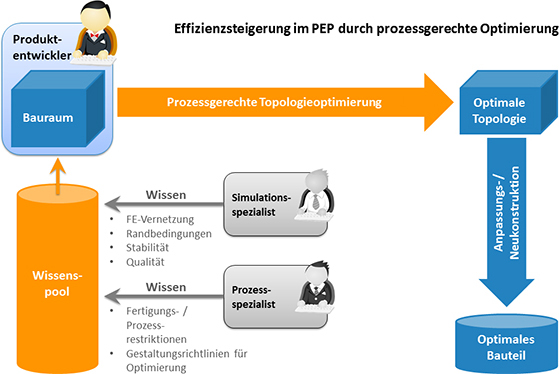Optimization as a design tool
A commonly used method in the contemporary virtual product development process is the structural optimization. Properly used as a tool in the design phase, it can improve the development of technically advanced and innovative products. The handling of commercial applications for structural optimization is often confusing and engineers mostly rely on the optimization result without deeper knowledge of the actual process of the software. Restrictions of fabrication are partially available and parameters from the manufacturing process are hardly used in the optimization process.

In this subproject the structural optimization will be integrated in the development process as a design tool at a procedural and a functional level. The focus is on the process as well as on the related product optimization. With different mathematical approaches and algorithms as well as constraints and parameters, the structural optimization generates a design proposal with consideration of target functions. At the moment, manufacturing constraints such as drafts or minimum / maximum structure sizes are taken into account. However, for a practical use these are often inadequate because restrictions of the production are not sufficiently reproduced and not all existing restrictions can be taken into account. The core of this project is on the one hand the identification and integration of parameters that influence the design of a product during the fabrication. These are flow rates or short flow paths during the casting, as well as the shape, length, width or height of draw beads during deep drawing. On the other hand, the product developers are given decision-making aids to select an appropriate optimization algorithm to solve the application problem. This facilitates the development process towards the “optimal” product under given restrictions and target function. To ensure this, the integration of the structural optimization in this research network is an important component. In close collaboration with the subproject partners and in cooperation with the industry, the findings around the product development and creation process must be identified, collected, structured and integrated. Derived from this, conceptual ideas for the development of a structural optimization software, which should take into account DfX criteria (Design for X), manufacturing constraints and process parameters beyond commercial tools, should be generated.
Partners from Industry
CG TEC GmbH
Herold & Co. GmbH
Schlaeger M-Tech GmbH
Scherdel GmbH
Universität Bayreuth
Lehrstuhl für Konstruktionslehre und CAD

Prof. Dr.-Ing. Frank Rieg
Second Spokesperson

Stefan Hautsch, M.Sc.
Subproject 9
Leader WG Product Simulation